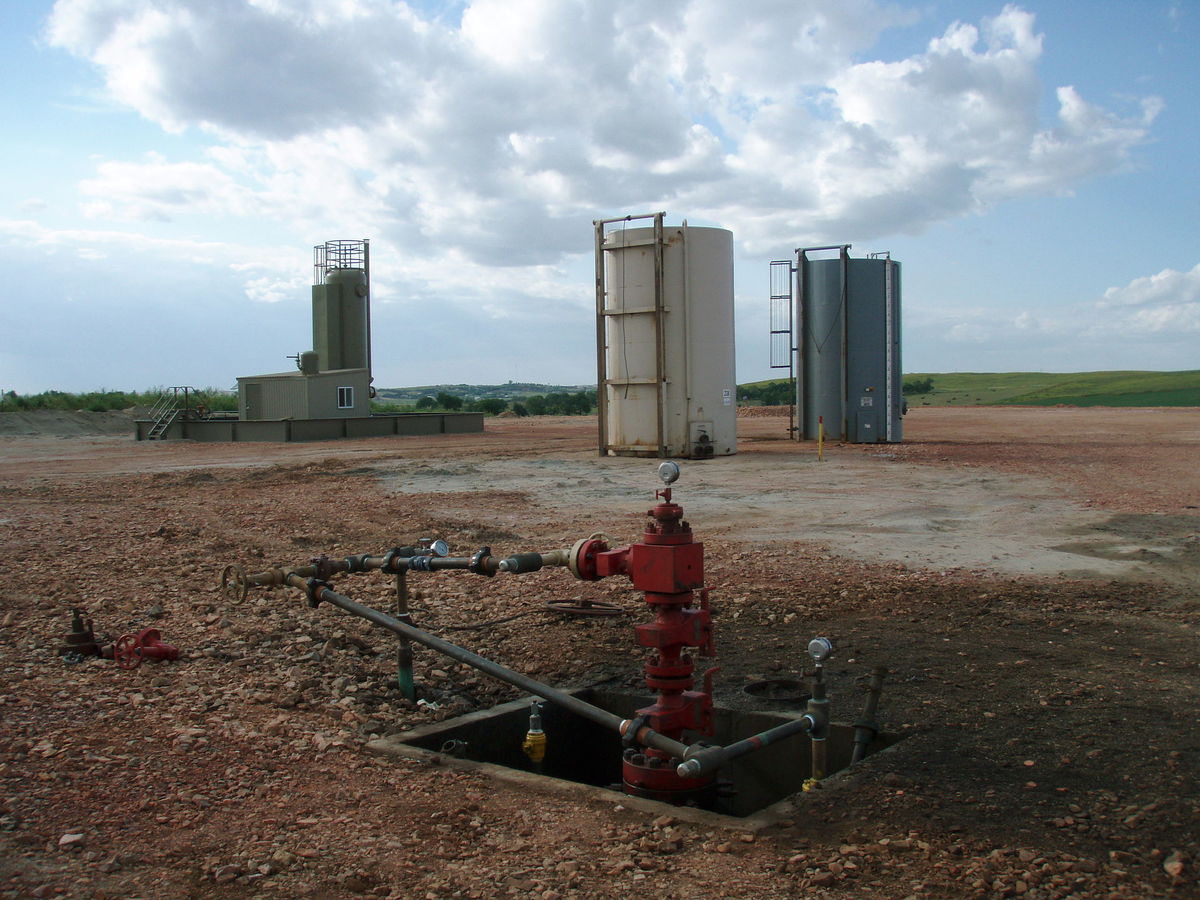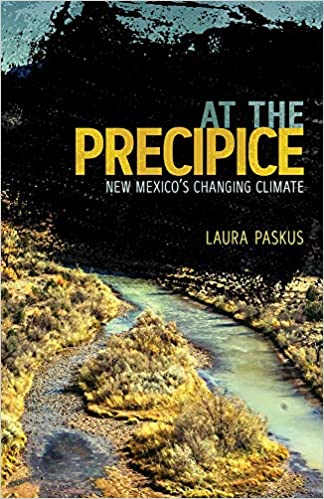
Well head after all the hydraulic fracturing equipment has been taken off location. Photograph Source: Joshua Doubek – CC BY-SA 3.0
Rancher Don Schreiber remembers San Juan County, New Mexico, in the 1950s, when its largest city, Farmington, was a company town. That company, El Paso Natural Gas, ran everything from the wells to the gas stations. It donated money to 4-H and the hospital; it pitched in to build Little League fields and the first nine holes of the local golf course.
“El Paso was still one of the most destructive forces of industry in the history of the world,” Schreiber said. “But [the people who ran it] fully participated in the community.”
Schreiber worked with his father, selling insurance for the oil and gas industry for 44 years. He’s seen plenty of things change since the 1950s, including the names of the companies, from El Paso to Meridian Oil to Burlington Resources Oil and Gas to ConocoPhillips to Hilcorp, the firm that bought out ConocoPhillips—four-story Farmington office building and all – for $3 billion in 2017.
“It’s all the same assets,” Schreiber said of the wells and pipelines that get bought and sold. “But every time the assets turn over, the new owner is less generous and further removed from the community.” Hilcorp, for example, closed its local office “and moved every executive out within weeks,” he said. “They wiped out the entire executive class of Farmington, shut the management headquarters down and moved all of that responsibility to Houston.” (Hilcorp’s public relations department did not respond to requests to comment for this story.)
The region’s economy has already been hit hard in recent years – by the retirement of units at the Four Corners Power Plant and the San Juan Generating Station, decreased property taxes and job losses in the natural gas industry over the course of roughly 10 years. The changes reverberate across the entire economy, leaving local governments with millions in budget shortfalls.
None of this is new for the Four Corners, a resource-rich area that comprises parts of New Mexico, Colorado, Arizona and Utah. Busts have rocked its economy ever since drillers began exploiting its petroleum reserves in the 1920s and mining its natural gas in the 1940s. Recent developments in extraction technologies, for natural gas in particular, have made its fields more productive but have also made the regional economy more vulnerable to crashes when natural-gas prices drop.
Recovery typically follows. But this bust feels different. “It feels like fossil fuels have met their demise,” said Mike Eisenfeld, the energy and climate program manager with the San Juan Citizens Alliance.
That doesn’t mean, however, “that people and families and communities should just be abandoned.”
* * *
Six years ago, when the U.S. Bureau of Land Management (BLM) was gearing up for new development, white pickup trucks zipped up Highway 550 in northwestern New Mexico. Tankers hauled water and chemicals and trailers pulled compressors and drill rigs down dirt roads. Just four years earlier, overproduction and falling prices had sent workers packing from the San Juan Basin’s natural gas fields.
But with advances in horizontal drilling and hydraulic fracturing, companies started showing renewed interest in the basin. The new technology made it possible to access resources that had in the past been uneconomical, or even impossible, to reach. In 2014 the federal agency started planning for how to develop roughly 2 million acres in the region.
Local communities and environmentalists resisted the new development – especially when the federal government began approving leases for exploratory wells near archaeological and sacred sites, such as Chaco Culture National Historical Park. But people in the oil and gas industries had high hopes. “Other parts of the country were seeing booms, certainly the Bakken and Marcellus, [because of] the evolution of this technology,” Eisenfeld said, referring to the Bakken Shale Play in Montana, North Dakota and Canada, and the Marcellus Formation in the Eastern U.S. “At the time, there was this glee that oil and gas here were going to be part of this boom.”
Eisenfeld was less optimistic. For decades, he had witnessed his community’s ups and downs. Even before COVID-19 gripped the world market and gut-punched demand for oil and natural gas, big companies had already pulled out of the San Juan Basin in New Mexico.
After ConocoPhillips sold off its assets in the basin, the Oklahoma-based WPX Energy left to focus on plays in the Bakken and Permian basins. That same year, Encana Oil and Gas left, too, followed in 2019 by Harvest Oil & Gas and BP American Production, which divested from the San Juan Basin and put that money toward other parts of the U.S. In 2014, the BLM’s Farmington field office approved more than 200 applications for permits to drill, or APDs. As September 2020 began, that number had dropped to 28.
Even down in the bustling Permian Basin on the New Mexico-Texas border, according toReuters, bids for New Mexico parcels in the BLM’s first post-pandemic lease sale ran in the hundreds of dollars per acre, not the thousands of dollars they brought in earlier in the year.
“The bust,” Eisenfeld said, “is the new norm.”
* * *
Despite forecasts showing little chance for recovery anytime soon, the BLM will “continue to lease as industry submits notifications of interest for certain oil and gas parcels,” Jillian Aragon, spokesperson for the BLM in Farmington, explained. In fact, she added, it has a congressional mandate to do so.
But in an August San Juan County Commission meeting, county manager Mike Stark said he doubted the San Juan Basin would ever relive the booms of its past. Ten years ago, 10 property owners were responsible for almost half the county’s  entire property tax revenue. Many of those have since left the region, and last year the top 10 taxpayers paid just 23 percent of the county’s property tax revenue.
entire property tax revenue. Many of those have since left the region, and last year the top 10 taxpayers paid just 23 percent of the county’s property tax revenue.
“If the revenue stays exactly as we’ve anticipated and budgeted for this fiscal year, that would leave us with a $4.6 million shortfall for 2022,” Stark told the assembled commissioners as he pulled up financial records onto a screen. To balance some of those losses, the county recently approved an increase in gross receipts taxes (GRT). But even that’s not likely enough.
“We’ve seen a dramatic downturn in GRT in the last five years,” Stark told me in a recent phone conversation. “Oil and gas production revenue has really fallen off the table.”
Looking at the forecasts out to 2030, Stark said there won’t be much of a swing on pricing. And if that’s the case, he said, companies aren’t going to drill new wells in the Four Corners. Companies will keep pumping from existing wells, but over time those will decline—and natural gas will be produced from other basins, like the Permian, where gas is the byproduct of oil drilling.
“Looking forward,” Stark said, “we shouldn’t count on another boom.”
* * *
Don Schreiber and his wife now run cattle on a ranch one county over from San Juan. But there’s no escaping the hand of industry: About 122 wells sit on and adjacent to their ranch. And he worries what might happen to them in the coming years as the industry moves on.
Right now, there are over 30,000 wells in the San Juan Basin, but only about 20,000 remain active.
“You’re in danger of orphaned and abandoned wells at every level: Your first concern is the small producer who just ducks out, that goes off and abandons their well or takes bankruptcy,” Schreiber said. The BLM and the state of New Mexico require companies to secure bonds to guarantee they’ll comply with regulations, including safely plugging wells once they’re no longer producing.
But Schreiber said the bonds are “wholly inadequate.” They represent just a fraction of what it costs to properly plug and abandon a well, which includes rehabilitating the well site, the road and any pipelines or other infrastructure.
Adrienne Sandoval, director of New Mexico’s Oil Conservation Division, agreed that the downturn comes with certain risks. “Companies on the margins of going out of business may be forced to make decisions that put compliance on the backburner,” she said. “We need to be as diligent as possible to make sure our regulations are being followed and we’re protecting human health and the environment.”
Two years ago, the state legislature increased the amount companies must set aside when bonding inactive wells and single wells.
This spring, with the onset of the novel coronavirus, the state also issued a new guidance for companies with wells that aren’t economically viable. Normally, wells are also subject to the state’s “plugging and abandonment rule” if they haven’t been active in 15 months. The changes, she said, “help operators buffer themselves” when prices are low. They could also reduce the risk that companies might just walk away, leaving their abandoned wells to fester, which would help people like Schreiber.
But nothing short of an economic transition—away from fossil fuels, and toward more sustainable industries – will likely arrest Farmington’s decline. “I’m heartbroken for the town,” Schreiber said. “At the same time, I’m furious they won’t embrace all the other opportunities they have – in ag, outdoor recreation and so many other gifts they’ve been given.”
Leaders could have seen the writing on the wall years ago, he said. Industry was already pulling out, the climate was warming and changes were necessary. Leaders could have put people to work on new technologies, rather than fighting federal and then state attempts at regulating methane emissions from the oil and gas industry.
“We could have said, ‘We could be a leader in these methane remediation products, we could figure out how to capture this gas and do that better and cheaper, and it’s something that’s needed all over the world,’” he said. “Instead of just sitting there, trying to take out that last drop of oil or last poof of gas.”
This story was generated by the investigative journalism project The Slick, published by Capital & Main.
